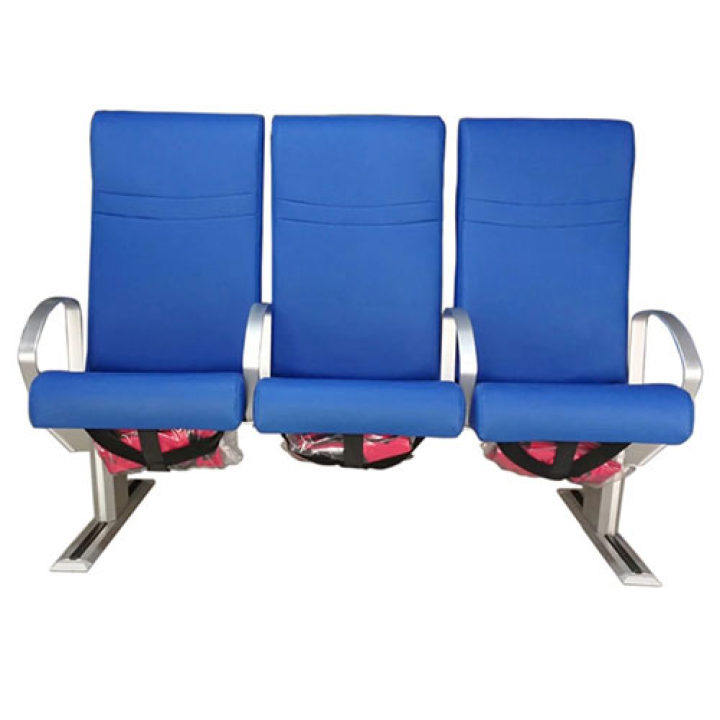Marine passenger seats play a crucial role in providing a comfortable and secure travel experience for passengers on various marine vessels. Whether it's a cruise ship, ferry, offshore vessel, or yacht, these seats are specially designed to withstand the unique challenges of the marine environment while offering optimal comfort and functionality. In this article, we will explore the design considerations, ergonomics, safety standards, and compliance requirements involved in creating marine passenger seats.

Design Considerations for Marine Passenger Seats
Ergonomics: Prioritize maximum comfort and support by considering seat height, width, depth, and backrest angle. Design seats that cater to diverse body types and promote proper posture for a comfortable travel experience.
Seating Configuration: Determine the best seating arrangement based on the vessel's layout and passenger capacity. Consider factors such as aisle width, legroom, and accessibility for passengers with mobility issues.
Seat Cushioning and Padding: Use high-quality cushioning materials that provide adequate support and pressure distribution. Marine seats are susceptible to vibrations and impacts, so choose materials that can withstand such conditions while ensuring passenger comfort.
Upholstery and Coverings: Select upholstery materials that are durable, water-resistant, and easy to clean in marine environments. Consider materials that are resistant to fading, mildew, and saltwater damage. Ensure that the coverings comply with fire safety regulations.
Safety Features: Incorporate safety equipment such as seat belts or harnesses to keep passengers safe during rough seas or unexpected vessel movements. Ensure that the safety devices are user-friendly and comply with relevant safety regulations.
Structural Strength and Stability: Design seats with sturdy frames and structures capable of withstanding the stresses encountered during maritime travel. Consider using corrosion-resistant metals or high-strength composites to ensure long-term durability.
Vibration and Shock Absorption: Implement mechanisms or materials that reduce the transmission of vibrations and shocks to the passenger seats. This can enhance passenger comfort and reduce the risk of fatigue or discomfort during long-distance travel.
Aesthetics and Branding: Create visually appealing designs that complement the overall interior aesthetics and branding of the vessel. Use color schemes, patterns, and finishes that enhance the passenger experience and reflect the maritime ambiance.
Maintenance and Cleanliness: Design seats that are easy to maintain and clean due to the presence of dirt, salt, and moisture in coastal environments. Consider using replaceable and washable seat covers, as well as components that are easily accessible for routine maintenance and repairs.
Regulatory Compliance: Ensure that the design and construction of marine passenger seats comply with relevant maritime safety and regulatory standards. This includes requirements for stability, fire safety, and evacuation protocols.

Ergonomics and Comfort of Marine Passenger Seats
The ergonomics and comfort of marine passenger seats are crucial factors in improving the overall travel experience and ensuring passenger satisfaction. Here are key considerations to prioritize when designing marine passenger seats:
Seat Contouring: Design seats that conform to the natural curves of the human body, providing optimal support and promoting proper posture. Consider the contours of the seat bottom, backrest, and headrest to evenly distribute pressure and reduce discomfort during prolonged sitting.
Seat Padding and Cushioning: Utilize high-quality padding materials that offer sufficient cushioning and shock absorption. The padding should strike a balance between comfort and support, relieving pressure points while maintaining stability. Consider incorporating foam or gel inserts to enhance comfort levels.
Lumbar Support: Include adjustable lumbar support to accommodate passengers with varying needs. Lumbar support helps maintain proper sitting posture by preserving the natural curve of the spine.
Seat Width and Depth: Ensure sufficient seat width and depth to comfortably accommodate individuals of all sizes. Seats that are too narrow or shallow can cause discomfort and restrict movement.
Armrests: Incorporate properly positioned and padded armrests to support passengers' arms and provide a resting place. Armrests should be at a comfortable height, allowing passengers to maintain a relaxed posture without raising their shoulders. Consider the optimal seat height to facilitate easy entry and exit for passengers.
Seat Height: Consider the appropriate seat height to facilitate passenger entry and exit. Seats should align with the deck height of the vessel, allowing passengers to firmly plant their feet on the floor for stability.
Seat Upholstery: Choose upholstery fabrics that are not only comfortable but also resistant to water, mildew, and stains. Seats in marine environments are exposed to water splashes, salt, and other impurities, so selecting durable, water-resistant textiles or marine-grade vinyl is essential.
Ventilation: Incorporate ventilation features into the seat design to improve airflow and prevent heat buildup, particularly in warmer climates. Proper ventilation can help reduce perspiration and enhance passenger comfort.
Noise and Vibration Dampening: Implement measures to minimize the transfer of noise and vibration to the seats. This may involve using vibration-absorbing materials or isolating the seat mounting from the vessel's structure to alleviate discomfort caused by vibrations and engine noise.
Accessibility: Ensure that the seats are designed to accommodate passengers with mobility issues, such as those using wheelchairs or walkers. Consider wider seat dimensions, retractable armrests, and unobstructed pathways throughout the seating area for easy movement.
Safety Standards and Compliance of Marine Passenger Seats
Regulatory Requirements: Familiarize yourself with applicable norms and standards for marine passenger seating, including recommendations from organizations such as the International Maritime Organization (IMO), the United States Coast Guard (USCG), and classification societies like Det Norske Veritas Germanischer Lloyd (DNV GL) or Lloyd's Register (LR). Stay updated on any revisions or amendments to these regulations.
Seat Strength and Durability: Marine passenger seats must have structurally sound frames capable of withstanding the dynamic stresses experienced during vessel operations. Consider seat frame materials, reinforcements, and load testing to ensure appropriate strength and durability.
Fire Safety: Materials used in marine seating must meet fire safety standards, such as the International Convention for the Safety of Life at Sea (SOLAS) requirements for fire resistance. Use fire-retardant materials and ensure compliance with relevant flammability standards, such as the International Maritime Organization's Fire Test Procedures Code (FTP Code).
Seat Belt Systems: Install proper seat belt systems to enhance passenger safety and minimize the risk of injury during turbulence or accidents. Follow industry-standard seat belt designs, including buckle types, webbing strength, and attachment points. Consider utilizing a three-point or lap-and-shoulder seat belt.
Impact Resistance: Design seats with impact-resistant characteristics to minimize the effects of collisions or incidents. Reinforce seat constructions and attachment points to withstand impact forces and minimize the risk of seat detachment or failure.
Slip Resistance: Use slip-resistant materials or surface treatments on seat surfaces and surrounding areas to prevent passengers from slipping or falling, particularly when the vessel is in motion or during wet weather conditions.
Accessibility: Ensure that marine passenger seats meet accessibility requirements to accommodate individuals with disabilities. Consider factors such as seat height, armrest design, and maneuvering space to facilitate ease of use for passengers with mobility challenges.

Documentation and Certification: Maintain detailed records of seat design, materials, manufacturing processes, and compliance testing. Obtain necessary certificates or approvals from recognized authorities or classification organizations to demonstrate compliance with safety standards.
Crash Testing: Consider conducting crash tests or simulations to assess the performance of the seats during impact scenarios. This can help identify areas for improvement and validate compliance with safety regulations.
Ongoing Compliance Monitoring: Regularly review and evaluate seat designs and materials to ensure continuous compliance with evolving safety requirements and standards. Stay informed about industry developments, safety bulletins, and best practices to ensure the safety of marine passenger seats.
Summary
Marine passenger seats are not only essential for safety but also contribute to the overall passenger experience on the high seas. These seats are designed to provide comfort, durability, compliance with safety regulations, and accessibility for all passengers, from luxurious cruise liners to efficient ferry services. By prioritizing ergonomics, safety standards, and design considerations, marine passenger seats can offer passengers a pleasant and secure journey at sea.







